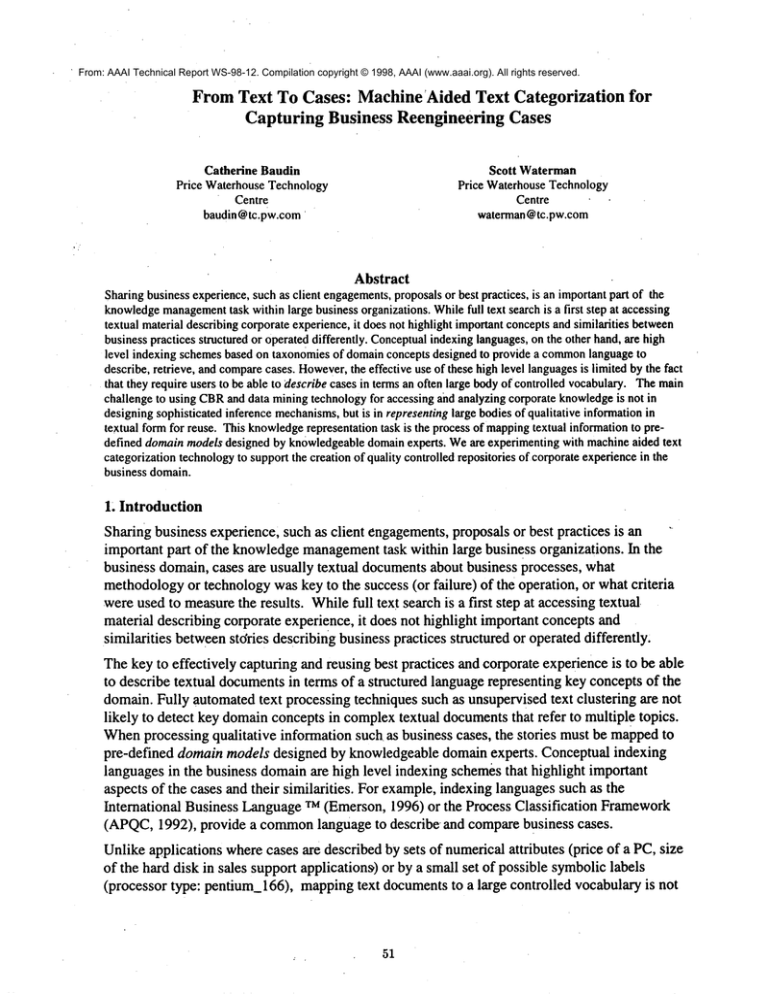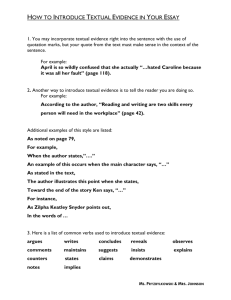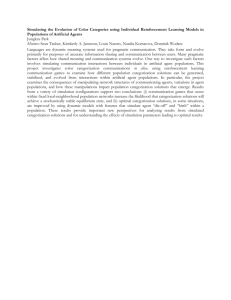
From: AAAI Technical Report WS-98-12. Compilation copyright © 1998, AAAI (www.aaai.org). All rights reserved.
FromText To Cases: MachineAided Text Categorization for
Capturing Business Reengineering Cases
Catherine Baudin
Price WaterhouseTechnology
Centre
baudin @tc.pw.com
Scott Waterman
Price WaterhouseTechnology
Centre
waterman@tc.pw.com
Abstract
Sharingbusinessexperience,suchas client engagements,
proposalsor best practices, is an importantpart of the
knowledge
management
task withinlarge businessorganizations.Whilefull text searchis a first step at accessing
textual materialdescribingcorporateexperience,it doesnot highlightimportantconceptsandsimilarities between
businesspractices structuredor operated differently. Conceptual
indexinglanguages,on the other hand,are high
level indexingschemesbased on taxonomiesof domainconcepts designedto provide a common
languageto
describe,retrieve, andcompare
cases. However,
the effective use of these high level languagesis limitedby the fact
that they require users to be able to *describecases in termsan often large bodyof controlledvocabulary.Themain
challengeto usingCBRanddata miningtechnologyfor accessingand analyzingcorporateknowledge
is not in
designingsophisticatedinferencemechanisms,
but is in representinglarge bodiesof qualitative informationin
textual formfor reuse. This knowledge
representationtask is the processof mapping
textual informationto predefined domainmodelsdesignedby knowledgeable
domainexperts. Weare experimentingwith machineaidedtext
categorizationtechnology
to supportthe creationof quality controlledrepositoriesof corporateexperiencein the
business domain.
1. Introduction
Sharing business experience, such as client engagements, proposals or best practices is an "
important part of the knowledge managementtask within large business organizations. In the
business domain, cases are usually textual documents about business processes, what
methodologyor technology was key to the success (or failure) of the operation, or what criteria
were used to measure the results. Whilefull text search is a first step at accessing textual.
material describing corporate experience, it does not highlight important concepts and
similarities between st6ries describing business practices structured or operated differently:
The key to effectively capturing and reusing best practices and corporate experience is to be able
to describe textual documents in terms of a structured language representing key concepts of the
domain. Fully automated text processing techniques such as unsupervised text clustering are not
likely to detect key domain concepts in complextextual documents that refer to multipl e topics.
Whenprocessing qualitative information such as business cases, the stories must be mappedto
pre-defined domain models designed by knowledgeable domain experts. Conceptual indexing
languages in the business domain are high level indexing schemes that highlight important
aspects of the cases and their similarities. For example, indexing languages such as the
International Business Language TM(Emerson, 1996) or the Process Classification Framework
(APQC,1992), provide a commonlanguage to describe and compare business cases.
Unlike applications where cases are described by sets of numerical attributes (price of a PC, size
of the hard disk in sales support applications~) or by a small set of possible symbolic labels
(processor type: pentium_166), mapping text documents to a large controlled vocabulary is not
51
only time consumingbut is also a complexdecision process that involves humanjudgmentto
decide what a documentis really about. In particular, business taxonomiescan contain several
hundredto several thousand concepts.
Weare currently investigating techniques and tools to facilitate the mappingbetweentextual
information and structured case representations using large indexing taxonomies.This paper
summarizesour experience with using machineaided text categorization to support the capture
of best practice knowledgefor our consulting practice. Onecharacteristic of such a corporate
repository is the importanceof the accuracyof the stored informationand of the wayit is
represented. For this reason wehave been researching the use of text categorization technology
(Lewis96, Jameset al 95, Borkoet al 65) to support humanindexers rather than as fully
automatedtext classification systems.
In section 2 we briefly describe the use of business process taxonomiesand showexamplesof
¯ questions that can be answeredusing these structured case representations. In section 3 we
present a machineaided text categorization tool called the IndexingAssistant that helps
informationspecialists turn textual business stories into structured cases. Section 4 summarizes
the key issues and points to directions for future research.
2. Using Business Taxonomiesto Describe Business Cases
Conceptuallanguages, such as the International Business Languager~t (IBL) (Emerson,1996),
provide a common
language for the identification of business improvementideas. This language
breaks business processes into activities that are shared by all companies,regardless of
industries, enabling the comparisonbetweencompaniesthat maybe structured or operated
differently. For instance, consider the followingsummarizedbusiness Stories:
Case 1: "CompanyX, a petroleum company,had a problem with its purchasing operation
and implementeda neworder tracking system using an Intranet. This resulted in a 60%
improvementin order processing time".
Case2: "CompanyY, a high-tech company,implementeda new networking electronic
requisition systemand found that it reducedthe purchasecycle time by 50%".
Althoughthese cases ¯use a different vocabulary(purchasing system vs. Requisition system) and
refer to companiesin different industries, they are similar in that they both refer to the same
business processes (orders and purchasingprocesses), and that they used similar enablers
reengineer the processes. Wewouldlike to producethe following conceptual description of
case 1 (wherethe attributes in bold are common
to both case 1 and case2).
Type: Engagement
Client: X
Project Lead:JohnFoo
Processes: OrderMaterials/Supplies,Receive Materials/Supplies
Enablers: EDI (Electronic Data Interchange)
Measures: Purchase Orders (Volume/Frequency)
Text:<the textual representation of the document>
Sucha conceptualdescription is the key to retrieving similar cases that mightbe missedby a
search based on exact keywordsin a query.
52
In addition to retrieving informationstored explicitly in a form of text documents,such structured
representations can also be used to extract implicit informationfrom the case repository by
drawinginferences on case attribute relationships. Examplesof implicit information that can be
inferred fromstructured cases like casel are:
¯
¯
¯
¯
Searchingfor experts in different process areas within a company:Whohas expertise in reengineering the order processing function? (John Foo because he has been associated with
several engagementsin this area).
Whoin the firm has a business relationship with companyX?
Whatare the mainenablers that are currently used to reduce order processing time? (trend
analysis).
Howmuchexperience do we have in using EDIfor reengineering the order processing
function?
Answeringthese types of questions from raw text is extremely difficult. However,these answers
are relatively easy to infer froma set of well structured cases such as the one shownin our
example.
In reality of course, textual business stories are rarely as concise and focused as the twoexamples
presented above. Theycar/be large documentsdescribing the operation of several business
processes over a period of several months.Mappingtext to cases is an indexing task that requires
both a deep knowledgeof a particular classification system and a goodunderstandingof the key
issues discussed in the documents.For these reasons, in manycompanies, documentsare
structured (indexed) manuallyby knowledgeablecorporate librarians rather than by authors or
people whoroute documentsfor sharing. This is a time consumingprocess. In our experiments
for instance, an informationspecialist trained in using process taxonomiesto describe business
reengineering documentsmanuallyindexes 7 to 18 documentsper hour.
Thenext section briefly presents the IndexingAssistant, a tool that facilitates the cl:eation of
repositories of business cases that can be then exploited by CBRand data miningtools.
3. FromText to Cases:MachineAided Indexing of Business Reengineering Stories.
Theprocess of turning a documentinto a structured business case involves mappingthe text of
the documentto a taxonomyof pre-defined business concepts. TheIndexing Assistant uses text
categorization technologyto help informationspecialists choose appropriate descriptors (or
categories) from the taxonomy.To support the decision process, it allows the user to investigate
the evidence supporting the system’s recommendations.The Indexing Assistant is currently used
as a front end to a repository containing morethan 6000 business cases shared through a Lotus
Notes database.
Figure 1 illustrates part of this knowledgemanagement
proc.ess. DocumentX is a text describing
someactivity (e.g. a consulting engagementwith a client)~ X is first routed to an information
specialist for approval. TheIndexingAssistant then helps the informationspecialist select
attributes froma controlled vocabularyin order to generate a structured representation of the
documentcontent. Theresult is a structured representation of the text containing descriptors
representing what the business story is about (what processes were used, what methodswere
used and what measuresare used to assess the results). Personal and companynamesare not part
53
of the taxonomy, but can be added separately as the byproduct of automated workflow (for
example, whena document is created in Lotus Notes the nameof the author is automatically
added as a descriptor of the document).
The saved documentis then ready to be processed for retrieval using full text search, category
based retrieval (show engagements that use "knowledge sharing" as an enabler), similarity-based
retrieval (CBR), or more general data mining techniques.
Business Taxonomy
Retrieve cases
similar to case X
Documen: X
Type Engagemer
Company X
Industry-’l
Processes:Pi, P2
Enablers’.E
I
Measures’2d1
Text:
1
/
Indexing Assistant
Document X
/
Case: X ’
MappingText to Cases
What technologies
are most used to
re-engineer process PI?
Figure 1: Structuring and Processing Cases for KnowledgeManagement
The following subsection describes the Indexing Assistant in more detail and shows how the
system interacts with humanindexers to help them turn text documents into structured business
cases.
The Indexing Assistant
The Indexing Assistant integrates a trainable text categorization tool as in (Lewis 96, James and
al 95, Borko and al 65). The input to the training componentis a set of examples categorized
manually, the output of this training phase is a dictionary of weighted term/category associations
that can then be used to automatically categorize new documents.
Wetrained the categorizationcomponent on a set of two thousand manually indexedcases
representing best practices, engagements with clients, and benchmarkingstudies. After the
system has been trained, the categorizer takes a documentand presents the user with a weighted
list of candidates. The user can then select a category to see the terms in the documentthat are
highly correlated with the category before selecting or rejecting the system’s recommendations.
At the end of this process the categories selected by the user are added to the ¢:ase representation.
54
This article discusses somecommon
obstacles to peer evaluationsandideas on
howto alleviate thoseproblems.
Enablers
Fmm S-WorkTeams
¯
C-TraL~ng
r" ¯
c.c ommunic
ation(Inte~ er s onal~
[’7 ¯
C-Emolovee
Incentives
- -
~
,~
Manymanagers
andCEOssharea common
reservation
aboutte~u,o~
T-Process Automat/on
~.~i ~ I
systems. How
r" I
T-~vstemsIntegration
d~*i
should performance
appratsais be done?Shouldthe manager
do them. the team
~
~.
~
I
leader, or should teem members
evaluate each othe~ Whiletaainin~ shared
~oal~, andgoodcoachingmakea difference, teemswon’tcoalesce unless
:~’: [’- I
T-EDIfElectronicDataInterchan2e~
peffomiance
appraisalsandraises te:vardteemachievements,
not just ir, di~idual ~ii Measures
contributions.
.
*%"~ ["I PR-Proc~ct,wtyfl’l~ouu.h~ut
.....
~’,i~
Obstacles
~ii| Processes
In atraditionalpenCo~mance
apptat.~al~’/stem. amanager
distributes ratings
,~,:~ F" MM~’R-Reco~uze & RevtardParfonuance
andraises accordingto his or her ownstendards. Wharethepowerresidesis ~,::,!| ~v’ ¯ ]-~-Plan&DeliverEnwloveeTrainm2
clear. In a peerevaluationprocess,rulesof the gameare less clear. The
.~:i|
.u" , , .....................
, ~
16 Important Texmsfor
’~Hl~.-B.ecognize & ~eward Perfom~-alce"
~
~,:
~
,,
’~;
,~
~!
.* ~ x I : reward
¯ ~ x2:individual
¯
X: pee~,
~%’!
,-
tiiiiiii:iiiiiiiiiiiiiiii
iiiiiiiiii‘
iiiiiiiiiiii
iiiiiiii
.iiiiiiiiiiiiiiiiiiiiiiiiiiiiiiiiiiiiiiiiii!iiiiiiiiiiiiiii
i:iiiiiiiiiiiiiiiiiiiiii
iiiiiiiiiiiiiiiiiiiiiiiiiiiiiiiiiiiiiiiiiiiiiiiiiiiiiiii!
F@ure2: Indexing Assistant interface
Figure2 illustrates part of a typical interactionwitha user. Thetext Of the document
being
indexedis shownin the top left frame.
Document
Categorization: Thesystem performsa global analysis of the documentcontent by
categorizingthe text. Thetop N (20 shownhere) rankedcategories are presentedin the top right
windowand are groupedinto the majordivisions of the taxonomy.Thestrength of each
recommendation
is indicated by the widthof a slider.
CategoryEvaluation:categories can be compared
by obtaininglist of termsin the text that are
high indicators of these categories. In this examplethe systemsuggests that the "Recognize&
RewardPerformance"process and the "WorkTeam"or "Training"enablers might be good
categories to describethe business problemin the document
andthe methodused to solve it.
Whenthe user selects "Recognize&RewardPerformance"
fromthe list of suggested categories,
the systemdisplaysa list of termsin the text that relate to this category(bottomframe).In this
case, the systemdisplays termssuch as reward,individual and peer evaluationthat are high
indicatorsof the selected process. Thesetermsare highlightedin the text to help the user assess
the recommendation
in the context of the story. This kind.of interaction with the systemallows
the user to elicit informationaboutthe relationship betweendocument
andcategories, and helps
providethe justification requiredto makecategorizationdecisions.
CategorySelection: Theuser accepts a set of systemrecommendations
for describing the
document
by checkingthe boxesassociated with one or morecategories. In this examplethe
55
resulting case might be coded as Enabler: Training, Process: Recognize & RewardPerformance
to indicate that this documentis about solving a peer evaluation problemby training employees.
Mostdocumentsin our application are associated with several categories.
Althoughthe resulting case representation is too abstract to be useful as a stand-alone description
of the documentcontent, it is a powerfulwayof describing a story whenit is associated with the
text document.Weare currently running experimentswith professional corporate librarians to
measurethe impact of using such case structuring aid on indexing time, accuracy and
consistency. Our preliminary results indicate that the assistive systemimprovesindexing
performancein all three aspects.
4. Conclusion
Anessential part of knowledgemanagement
in large organizations involves sharing and reusing
textual information. Usingconceptual languages such as business taxonomiesto describe
informationnot only facilitates the retrieval of text documentsbut also uncoversimplicit
knowledgeby detecting patterns in sets of documents(see examplesin section 2). A key factor
for being able to reuse qualitative information, such as lessons learned during consulting
engagementswith clients or best practice business reengineeringstories, is to maptext
documentsto conceptual languages based on domain models designed by knowledgeable domain
experts. In our application, such domainmodels(i.e. a controlled vocabulary)ai’e the main
drivers for detecting key conceptsin a text and for generating normalizedcase representations of
business knowledge.However,because this "translation" process is time consumingand requires
extensive training to be performedaccurately, there is a needfor tools that support the
formalizationof free text into structured cases.
"Wehave described a methodthat uses text categorization technologyto facilitate the creation and
maintenanceof case representations of business experience. Our approachis to first provide high
quality normalizedrepresentations of textual information that can then be processed by CBRor
data miningtools that operate on structured cases. This pre-processing approachto knowledge
management
is adequatefor creating relatively small (in the thousandsrather than in the
millions) quality controlled collections of text. However,extremelylarge collections (e.g. the
Web)cannot be pre-structured in this way, even with the help of assistive methodssuch as the
IndexingAssistant. We"are looking into trading somerepresentation accuracy and using text
categorization in a fully automatedwayto analyze text "on the fly" for processinglarger text
collections (Rissland & Daniels 95).
In addition to text categorization, there are other text processing methodsfor generatingcase
representations from text. Weare also investigating howto integrate text categorization with
informationextraction techniques (MUC-6,1996) that can identify precise entities (people
names,companynames,quantitative values) and their relationships.
References
Allan, James, Lisa Bailesteros, James P. Callan, W. Bruce Croft and Zhihong Lu. 1995. "Recent experiments with
INQUERY,"in Fourth Text Retrieval Conference (TREC-4).
Borko, Harold, 1964. Researchin computerbased classification systems. In International Study Conferenceon Classification
Research, 2"a ed, Munksgaard,Copenhagen,1965.
56
Emerson,J.,C. 1996. "Price Waterhouse’sKnowledgeView: Setting the Stage For Serving Clients In The Year
2000", in Emerson’sprofessional services review. March/Aprilissue.
Larkey, L.S. and W.B.Crofi, 1995. "Combining
classifiers in text categorization," in Proceedingsof the 19th annual
international ACM
SIGIRconferenceon research and developmentin information retrieval, Zurich, Switzerland.
th
Lewis,D.L.,Schapire,R.E.,Callan,J.P., Papka,R. 1996.Trainingalgorithmsfor linear text classifiers, in Proceedings
of the 19
Ann.Intl. ACM
SIGIRConf. OnRsch. AndDev.In InformationRetrieval.
MUC-6,1996. Proceedingsof the Sixth MessageUnderstandingConference(MUC-6).MorganKaufmann.
Porter, MichaeI,E., 1990. "Competitive Advantage".The Free Press. Collier MacmillanPublishers London.
Rissland, E.L. and Daniels, J.J. (1995). "UsingCBRto Drive !R.’I In Proceedingsof the Fourteenth International
Joint Conferenceon Artificial Intelligence (IJCAI-95), 400-407.Montreal, Canada.
57





